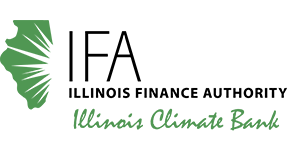Apply for the EE RLF Bridge Loan here: Pre-application Link
The EE RLF provides flexible financing solutions to support energy efficiency and clean energy projects in Illinois. The program offers Bridge Loans to cover gaps between project completion and disbursement of federal or state incentives, and Co-Lending/Participation Loans to support longer-term project financing. The fund is administered by the Illinois Finance Authority (IFA) and capitalized through a grant from the US Department of Energy.
Eligible projects must be commercial buildings, including multifamily buildings with five or more units, located in Illinois that have undergone a qualified energy audit.
For a brief explanation of the program, who can apply, and the types of projects financed, refer to this One Pager.
For full program details, summary loan terms, and eligibility requirements, refer to the EE RLF Initial Bridge Loan Strategy.
On February 19, 2025, the Illinois Finance Authority hosted its first Energy Efficiency Revolving Loan Fund webinar. Webinar resources are below.
02/19/2025 Webinar Slides
02/19/2025 Webinar Recording (password WqQg3Y9?)
